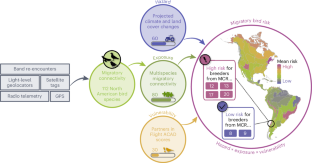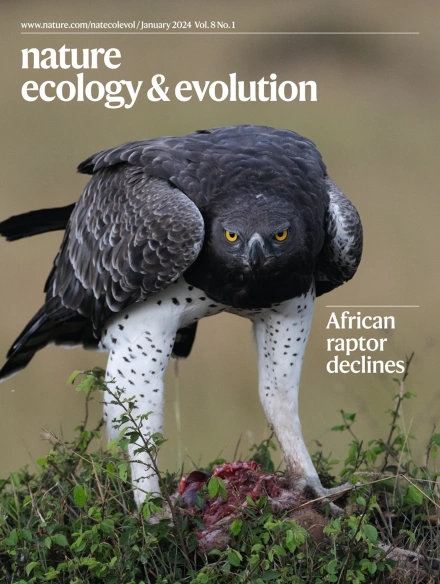Multispecies migratory connectivity indicates hemispheric-scale risk to bird populations from global change
IF 13.9
1区 生物学
Q1 ECOLOGY
引用次数: 0
Abstract
Global agreements to reduce the extinction risk of migratory species depend critically on intersecting migratory connectivity—the linking of individuals between regions in different seasons—and spatial patterns of environmental change. Here we integrate movement data from >329,000 migratory birds of 112 species to develop a parameter representing exposure to global change: multispecies migratory connectivity. We then combine exposure with projected climate and land-cover changes as a measure of hazard and species conservation assessment scores as a metric of vulnerability to estimate the relative risk of migratory bird population declines across the Western Hemisphere. Multispecies migratory connectivity (exposure) is the strongest driver of risk relative to hazard and vulnerability, indicating the importance of synthesizing connectivity across species to comprehensively assess risk. Connections between breeding regions in Canada and non-breeding regions in South America are at the greatest risk, which underscores the particular susceptibility of long-distance migrants. Over half (54%) of the connections categorized as very high risk include breeding regions in the eastern United States. This three-part framework serves as an ecological risk assessment designed specifically for migratory species, providing both decision support for global biodiversity conservation and opportunities for intergovernmental collaboration to sustain migratory bird populations year-round. On the basis of data from >329,000 migratory birds, this study presents multispecies migratory connectivity as a parameter representing exposure to global change and shows that connections between breeding regions in Canada and non-breeding regions in South America are at greatest risk from global change.


求助全文
约1分钟内获得全文
求助全文
来源期刊

Nature ecology & evolution
Agricultural and Biological Sciences-Ecology, Evolution, Behavior and Systematics
CiteScore
22.20
自引率
2.40%
发文量
282
期刊介绍:
Nature Ecology & Evolution is interested in the full spectrum of ecological and evolutionary biology, encompassing approaches at the molecular, organismal, population, community and ecosystem levels, as well as relevant parts of the social sciences. Nature Ecology & Evolution provides a place where all researchers and policymakers interested in all aspects of life's diversity can come together to learn about the most accomplished and significant advances in the field and to discuss topical issues. An online-only monthly journal, our broad scope ensures that the research published reaches the widest possible audience of scientists.
 求助内容:
求助内容: 应助结果提醒方式:
应助结果提醒方式:


